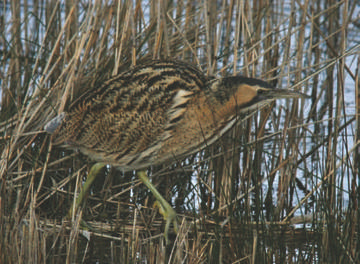Bittern (Botaurus stellaris)

Bittern © Jeff Clarke
Bitterns are never found away from phragmites reedbeds, where they patiently stalk their favourite food of eels, with some fish, amphibians and aquatic invertebrates, and occasional birds and small mammals if they come within reach. Some British birds, especially immatures, disperse from their breeding sites and the population is augmented by winter arrivals from the continent, with ringed birds having been recorded in Britain from Sweden, Germany, the Netherlands, Belgium (Migration Atlas) and France. One of the two from Germany was actually reported in Cheshire, a bird ringed as a chick at Königswartha, Saxony on 23 May 1931 and found dead here on 2 January 1932; and another Bittern chick ringed in Norfolk 16 May 1950 was found in Nether Alderley on 6 November 1950. These examples nicely show the possible origins of birds wintering in Cheshire. In recent years Bitterns have regularly frequented three sites – Rostherne Mere (SJ78L/ M), Budworth Mere (SJ67N) and Moore Nature Reserve (SJ58Y) – and it is no surprise that the Atlas map shows these, plus Deerpark Mere, Cholmondeley (SJ55K), where a bird was found on 17 February 2007. Two birds were found at Budworth Mere during 2004/ 05 and 2006/ 07, and up to three birds were at Moore in 2005/ 06.
In the 19th century, Bitterns were persecuted to extinction as a breeding bird in Cheshire and Wirral and a century ago, Coward (1910) reported that most wintering birds were killed: of 38 records, at least 28 of them were shot. Birds fared better in the 20th century, but were very scarce, with an average of about one a year recorded (Bell 1962). The annual county bird reports have documented an increase in records in the last forty years. Bitterns were found in five of the years 1967 to 1975, then in every year except 1987. There were no winter records until 1970/ 71 but then birds were seen in ten of the 17 winters to 1987/ 88 and in every winter since then. The rise is also illustrated by their more widespread occurrence: in the seven winters from 1988/ 89 to 1994/ 95 there were reports from one to three sites, while the nine year period 1995/ 96 to 2003/ 04 saw birds noted annually from up to seven sites. Movements around the county are impossible to assess but the frequency of sightings from Budworth Mere and Moore suggests that birds have often been present at both sites, and there have probably been five or more birds present in Cheshire and Wirral on occasion.
Bitterns are susceptible to hard weather, especially if their food is locked away beneath ice. In the exceptional frost of the first quarter of 1963, the warden at Rostherne Mere captured one Bittern, thought to have been starving, and fed it on liver for seven weeks; another bird managed to survive in the wild there at the same time, however. The next really cold winter, 1978/ 79, brought a widespread influx of continental birds to Britain and was probably responsible for records at Neston Reedbed, Doddington Pool and Tabley Mere.
The only records showing any breeding intent in the county were of males giving their characteristic far-carrying booming ‘song’ at Knutsford Moor on 19 March 1995 and at Budworth Mere on 6 May 1995. During this Atlas period a bird was heard booming ‘on at least one occasion’ in the early months of 2006 at Moore: Bitterns are individually identifiable by their sonogram spectrum, and observers should attempt to record any future booming birds (Gilbert et al 2002). Others were seen at Rostherne Mere on several dates in 2004 from 29 June onwards, and in 2005 from 10 July to 14 September, presumably examples of early dispersal from breeding sites elsewhere.
The species is responding to the UK Biodiversity Action Plan but the breeding population is still small (55-69 booming males in 2004 (Holling et al 2007)) and concentrated mostly in eastern England, where some two-thirds of the population is threatened by sea level rise. Conservation action to create suitably large reedbeds in Cheshire and Wirral would help to safeguard the Bittern’s future.
Sponsored by Matthew and Liz Bannon

